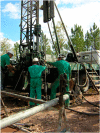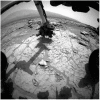Río tinto: a geochemical and mineralogical terrestrial analogue of Mars
- PMID: 25370383
- PMCID: PMC4206857
- DOI: 10.3390/life4030511
Río tinto: a geochemical and mineralogical terrestrial analogue of Mars
Abstract
The geomicrobiological characterization of the water column and sediments of Río Tinto (Huelva, Southwestern Spain) have proven the importance of the iron and the sulfur cycles, not only in generating the extreme conditions of the habitat (low pH, high concentration of toxic heavy metals), but also in maintaining the high level of microbial diversity detected in the basin. It has been proven that the extreme acidic conditions of Río Tinto basin are not the product of 5000 years of mining activity in the area, but the consequence of an active underground bioreactor that obtains its energy from the massive sulfidic minerals existing in the Iberian Pyrite Belt. Two drilling projects, MARTE (Mars Astrobiology Research and Technology Experiment) (2003-2006) and IPBSL (Iberian Pyrite Belt Subsurface Life Detection) (2011-2015), were developed and carried out to provide evidence of subsurface microbial activity and the potential resources that support these activities. The reduced substrates and the oxidants that drive the system appear to come from the rock matrix. These resources need only groundwater to launch diverse microbial metabolisms. The similarities between the vast sulfate and iron oxide deposits on Mars and the main sulfide bioleaching products found in the Tinto basin have given Río Tinto the status of a geochemical and mineralogical Mars terrestrial analogue.
Figures








References
-
- Des Marais D.J., Nuth J.A., Allamandola L.J., Boss A.P., Farmer J.D., Hoehler T.M., Jakosky B.M., Meadows V.S., Pohorille A., Runnegar B., et al. The NASA Astrobiology Roadmap. Astrobiology. 2008;8:715–730. - PubMed
-
- Ehrlich H.L., Newman D.K. Geomicrobiology. 5th ed. CRC Press; Boca Raton, FL, USA: 2008.
-
- Sand W., Gehrke T., Hallma R., Schippers A. Sulfur chemistry, biofilm and the (in)direct attack mechanisms—A critical evaluation of bacterial leaching. Appl. Microbiol. Biotechnol. 1995;43:961–966. doi: 10.1007/BF00166909. - DOI
Publication types
LinkOut - more resources
Full Text Sources
Other Literature Sources
Miscellaneous

